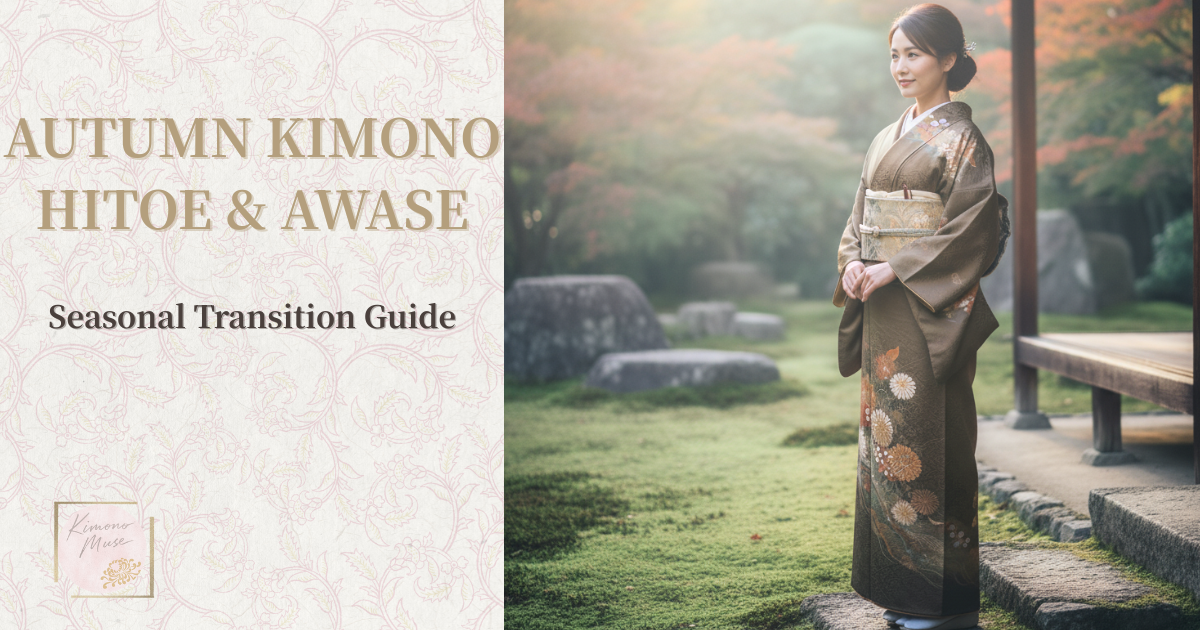Enjoying the changing seasons through kimono is one of Japan’s most cherished cultural traditions.
The long-standing practice of koromogae—seasonal wardrobe change—is not just about switching clothes, but also about appreciating the fabrics and colors that reflect the time of year.
In this article, we’ll explore the basics of the autumn kimono wardrobe change, along with practical tips for choosing what to wear depending on the weather and occasion.
Koromogae (Seasonal Kimono Change): Traditional Rules and Modern Approach
The tradition of koromogae in kimono dates back to court rituals, where changing one’s attire at seasonal milestones was considered an important custom.
In modern times, it is generally accepted that hitoe (unlined kimono) are worn in September, and awase (lined kimono) are worn from October onward.
However, with the effects of global warming, lingering summer heat is no longer unusual. Rather than following the calendar too strictly, it is important to choose your attire flexibly, according to the day’s temperature and your own comfort.
By carefully balancing three elements—the tailoring of the kimono (hitoe or awase), the fabric (its thickness and texture), and the colors—you can enjoy a comfortable and effortless seasonal style.
From Hitoe (Unlined Kimono) to Awase (Lined Kimono): Three Key Guidelines
The timing of the switch depends on where you live and the weather on a given day.
By keeping the following three points in mind, you can find the style that feels most comfortable for you.
1. Check the Temperature
While only a general guideline, temperature is one of the most important hints when choosing which kimono to wear.
25°C (77°F) and above: Hitoe (unlined kimono) is still the most comfortable choice.
20–24°C (68–75°F): Either hitoe or awase (lined kimono) can be worn. Consider the atmosphere of your destination and indoor air conditioning when deciding.
19°C (66°F) and below: Awase is the safer option. Especially on windy days or in the early morning and evening, when the perceived temperature drops, warmth becomes more important.
2. Consider the Calendar and Regional Differences
The basic rule is “hitoe in September, awase in October.”
However, it’s important to adjust according to the climate where you live—for example, lingering late-summer heat in urban areas or the early chill in colder regions like Hokkaido.
If you feel the coolness in the mornings and evenings, or notice stronger winds against your skin, it may be time to bring out your awase.
3. Special Considerations for Formal Wear
At formal occasions such as weddings, it is safest to follow the seasonal calendar.
For ceremonies held in October or later, awase (lined kimono) is generally expected.
However, if unusually high temperatures are forecast, wearing hitoe (unlined kimono) is often considered acceptable.
Maintaining proper formality with your obi and accessories, while also prioritizing your comfort and health, is an important part of good manners.
Styling Kimono for Autumn: Practical Tips
To fully enjoy wearing kimono in comfort, it’s not only the kimono itself that matters—the key lies in how you adjust with accessories and inner layers.
・Expressing the Season Through Fabric and Tailoring
In the latter half of September, when hitoe (unlined kimono) is still worn, choosing slightly heavier fabrics such as tsumugi (pongee silk) or chirimen (crepe) can create a stronger sense of the season.
When October arrives and you switch to awase (lined kimono), opting for a lighter lining (doura) or a smooth nagajuban (under-kimono) helps you stay comfortable without feeling weighed down.
For accessories, transition from thin tabi socks to standard ones, and switch your haneri (collar) from summer-friendly ro (sheer fabric) to one with a more subdued luster.
These small changes bring the entire look together with a sense of autumn.
| Season/Timing | Kimono Type | Styling Tips |
|---|---|---|
| Late September | Hitoe (unlined kimono) | Fabrics with a bit more weight and texture, such as tsumugi or komon, are recommended. They give a calm, refined impression and help you feel the arrival of autumn. |
| From October onward | Awase (lined kimono) | Choose lined kimono such as houmongi (formal visit wear) or komon (casual patterns). Opt for lighter linings and smooth nagajuban (under-kimono) for comfort. |
| Throughout the season | Accessories | Switch from thin tabi to standard thickness. Change haneri (collar) from summer fabrics like ro to more subdued ones such as shioze or shusu to create an overall seasonal balance. |
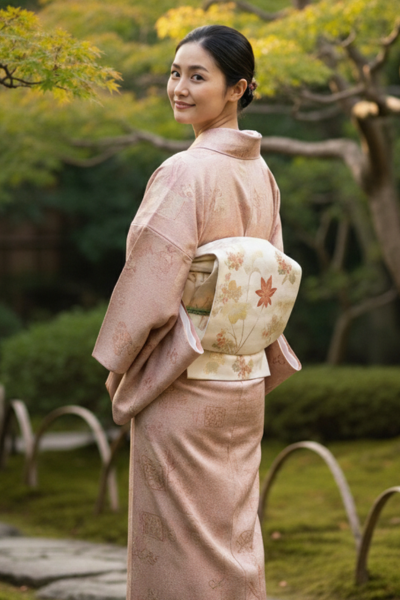
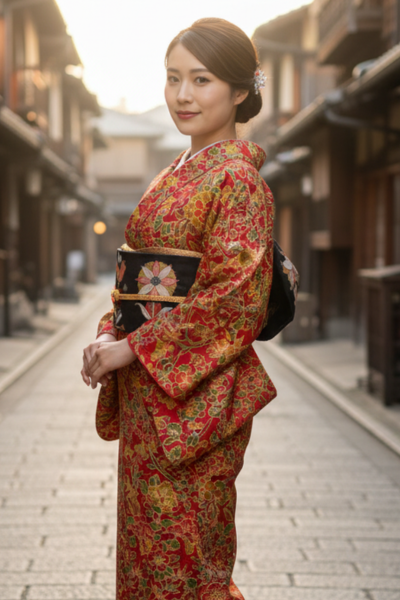
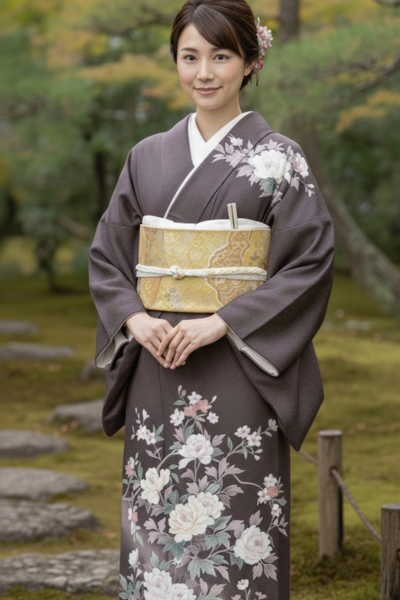
Tsumugi with an autumn-leaf obi, reflecting the beauty of a fall garden.
Komon with a sarasa-style pattern, perfect for a stroll or a theater outing.
Elegant hōmongi, adding grace to autumn gatherings and formal occasions.
・Regulating Temperature with Undergarments and Nagajuban
On days when you’re prone to sweating, moisture-absorbing and quick-drying innerwear is especially useful.
Even during the season for awase (lined kimono), simply adjusting the fabric of your nagajuban (under-kimono) can make a big difference in comfort.
Materials like hemp or silk are highly breathable and help you stay comfortable.
・Making the Most of Haori and Shawls
From the season of autumn leaves onward, the haori (kimono jacket) becomes especially useful.
On chilly, windy days, adding a large shawl keeps you comfortable when moving between indoors and outdoors or while waiting outside.
By November, items like the michiyuki (straight-cut overcoat) or other kimono coats are often needed.
Having outer layers that can be easily put on and taken off over your kimono allows you to adapt flexibly to changes in temperature.
| Type | Features | Usage |
|---|---|---|
| Haori | A short jacket worn over kimono, like a cardigan or light jacket. Unlike coats, it doesn’t need to be removed indoors. | Casual outings or stylish wear. Haori with family crests can also serve as semi-formal attire. |
| Michiyuki Coat | Distinctive square neckline, designed as a protective outer garment. | Suitable for formal kimono such as hōmongi or tomesode. |
| Dōchūgi | Wide neckline, allowing a clean look around the chest area. | Versatile—matches everything from casual komon to formal tomesode. |
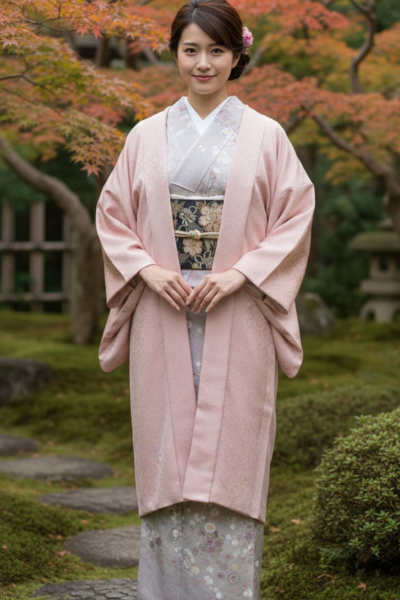
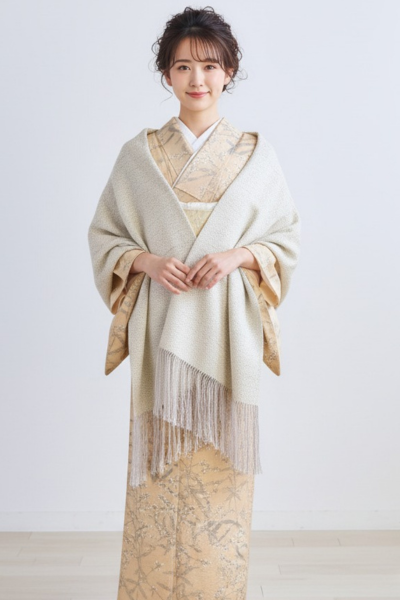
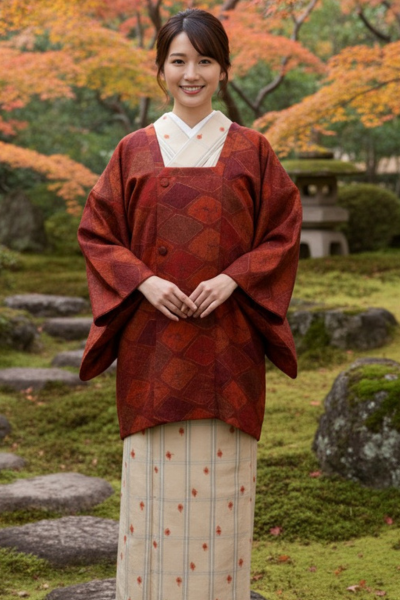
Light haori, adding elegance to autumn outings.
A graceful shawl, perfect for warmth and style.
Rust-colored michiyuki coat, bringing seasonal charm.
・Adding Subtle Elegance with Obi Accessories
The obiage and obijime are essential “fine-tuning parts” for autumn styling.
In September, opt for light and airy materials, and from October, switch to slightly matte textures to create a more seasonal look.
For colors, instead of overly vivid tones, choose muted shades or mid-tones to achieve a calm and sophisticated coordination with depth.
🍂The Charm of Autumn Colors
Autumn colors are centered around refined, muted tones.
They carry warmth and evoke a subtle sense of traditional Japanese elegance.
Shades reminiscent of seasonal flavors—such as chestnut, persimmon, and grape—add to the charm of autumn.
Autumn is a season for appreciating art and food, and its atmosphere pairs beautifully with scenes of autumn foliage or historic temples and shrines in Kyoto.
Incorporating these tones into your outfit naturally brings out a distinctly wa (Japanese) aesthetic.

Autumn Kimono Color Chart: Muted Tones, Warmth, and Shades Inspired by Fall Flavors
Use this as a reference for kimono color coordination, especially when selecting obiage (sash scarf) and obijime
Q&A: Kimono Wardrobe Transition in Autumn
**Q1: Is it okay to wear a hitoe (unlined kimono) on hot days in October?**
A: Yes, comfort comes first. While awase (lined kimono) is standard for formal occasions, on hot days you can wear a hitoe with a formal obi and accessories to maintain elegance. If the host specifies a dress code, follow that.
**Q2: How do I decide when to switch to awase (lined kimono)?**
A: A good guideline is when the daily high is around 19°C (66°F). Also consider morning and evening chill, wind, air conditioning, and whether you’ll be out during the day or at night.
**Q3: What are some tips for men’s autumn kimono coordination?**
A: Deep shades such as indigo, gray, and brown are ideal for autumn. Adding subtle accents—like rust (sabi-iro) or withered leaf (kuchiba-iro)—in haori cords or obi can make the outfit distinctly seasonal.
**Q4: From when can I start using haori or shawls?**
A: From mid-October, light haori are useful. On windy days, a large shawl provides extra warmth. By November, consider adding a dōchūgi or coat for more comfort.
**Q5: How should I choose a formal kimono in September (for ceremonies or photo shoots)?**
A: A hitoe formal kimono is generally appropriate. If the weather is still hot, choose lighter fabrics and refined accessories to maintain formality without discomfort. Always follow the event’s dress code if specified.
**Q6: Can I still wear summer kimono (cotton, gauze) in September?**
A: Traditionally, summer kimono are for June–August, and from September you switch to unlined kimono. However, as recent years have brought lingering heat into September, comfort should take priority for casual outings.
- Pair unlined kimono with breathable long undergarments (cotton, linen, light silk).
- Choose socks and undergarments with a cool texture.
For formal occasions or tea ceremonies, follow the seasonal rules: avoid sheer “summer” fabrics or obviously summer-patterned obi in September.
**Q7: Where should I adjust layers to stay comfortable?**
A: Temperature control around the neckline, back, and waist is key. On humid days, quick-dry undergarments help. In the unlined season, linen or silk juban (under-kimono) are ideal. In the lined season, a smooth juban combined with a thin underlayer keeps things light.
**Q8: When should tabi socks and undergarments switch to an “autumn look”?**
A: Gradually move from thin to standard-thickness tabi, and switch to slightly more luxurious undergarments around October. This creates a naturally seasonal appearance.
**Q9: Can year-round patterns still look seasonal?**
A: Yes. Even with solid colors, Edo-komon, or stripes, you can express autumn through obi, obijime, and undergarments by adjusting their colors and textures. This adds an autumnal touch and keeps the look refined.
Summary
The seasonal shift of kimono in autumn reflects the wisdom rooted in Japan’s climate and way of life.
Traditionally, the change from unlined hitoe to lined awase takes place from September to October, but in today’s climate it is important to prioritize temperature and personal comfort.
By adjusting with inner layers, under-kimono, haori, and shawls, you can maintain both elegance and well-being.
Following the calendar while adapting to your own comfort allows you to enjoy autumn kimono with beauty, balance, and ease.
・Autumn Kimono Dressing: Three Key Principles
- Respect the calendar, but prioritize comfort.
Avoid forcing yourself into formality; choose outfits that keep you comfortable. - Control temperature with accessories and layers.
Adjust with undergarments, under-kimono, haori, and shawls for subtle fine-tuning. - Balance elegance and well-being.
Aim for attire suitable to the occasion while taking care not to compromise your health.
We hope this article will inspire and enrich your autumn kimono life.
✿Column: Fumi’s Kimono Diary ✿
From September to October, I love watching the city gradually take on the colors of autumn.
One year, around the time of seasonal wardrobe change, I had just switched from hitoe (unlined kimono) to awase (lined kimono). The moment I slipped my arms into the sleeves, I thought, “Ah, the layers of fabric feel so comforting.”
That gentle weight felt as if I were being wrapped in the autumn air itself, and I remember realizing that the season had taken another graceful step forward.
Especially now, when the climate can be unpredictable, finding your own way of transitioning—based on your health and mood—may be the secret to enjoying kimono for many years to come.
